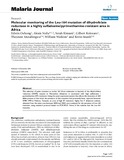| dc.contributor.author | Ochong, E | |
| dc.contributor.author | Nzila, A | |
| dc.contributor.author | Kimani, S | |
| dc.contributor.author | Kokwaro, G | |
| dc.contributor.author | Mutabingwa, T | |
| dc.contributor.author | Watkins, W | |
| dc.contributor.author | Marsh, K | |
| dc.date.accessioned | 2013-06-11T07:02:26Z | |
| dc.date.available | 2013-06-11T07:02:26Z | |
| dc.date.issued | 2003-12 | |
| dc.identifier.citation | Malar J. 2003 Dec 15;2(1):46 | en |
| dc.identifier.uri | http://www.ncbi.nlm.nih.gov/pubmed/14675491 | |
| dc.identifier.uri | http://erepository.uonbi.ac.ke:8080/xmlui/handle/123456789/31140 | |
| dc.description.abstract | The selection of point mutation at codon 164 (from isoleucine to leucine) of the dihydrofolate reductase (DHFR) enzyme in Plasmodium falciparum is associated with high sulfadoxine /pyrimethamine (SP) resistance. Using the yeast expression system that allows the detection of dhfr allele present at low level, the presence of this mutation had previously been reported between 1998-1999 in Muheza, Tanzania, an area of high SP resistance. Eighty five P. falciparum isolates, obtained from the same area between 2002 and 2003, were analysed for the presence of Leu-164 mutation, using standard protocol based on PCR-RFLP. None of the isolates had the Leu-164 mutation | en |
| dc.language.iso | en | en |
| dc.publisher | University of Nairobi | en |
| dc.title | Molecular monitoring of the Leu-164 mutation of dihydrofolate reductase in a highly sulfadoxine/pyrimethamine-resistant area in Africa | en |
| dc.type | Article | en |
| local.publisher | College of Health Sciences | en |


